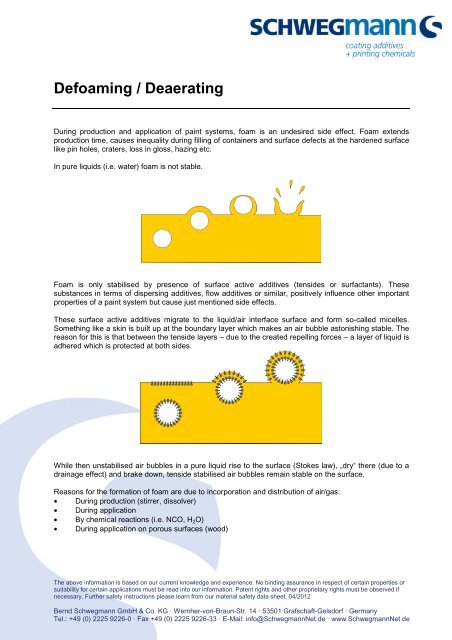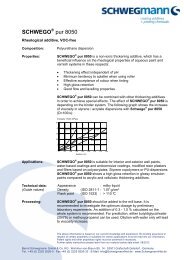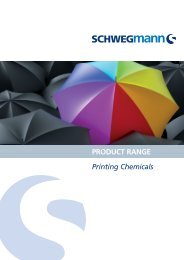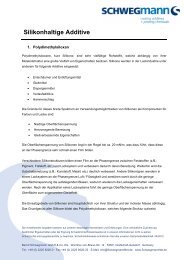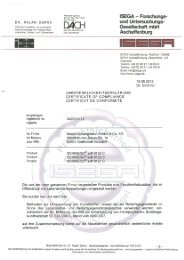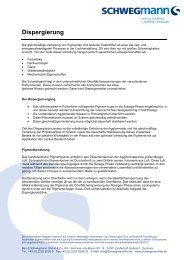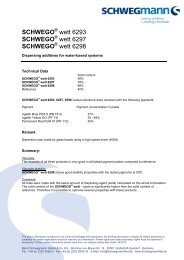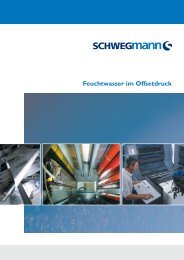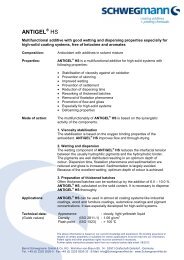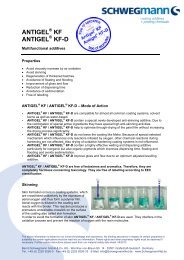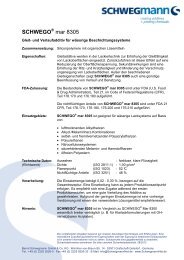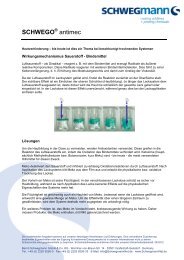Defoaming / Deaerating - Bernd Schwegmann GmbH & Co. KG
Defoaming / Deaerating - Bernd Schwegmann GmbH & Co. KG
Defoaming / Deaerating - Bernd Schwegmann GmbH & Co. KG
You also want an ePaper? Increase the reach of your titles
YUMPU automatically turns print PDFs into web optimized ePapers that Google loves.
<strong>Defoaming</strong> / <strong>Deaerating</strong><br />
During production and application of paint systems, foam is an undesired side effect. Foam extends<br />
production time, causes inequality during filling of containers and surface defects at the hardened surface<br />
like pin holes, craters, loss in gloss, hazing etc.<br />
In pure liquids (i.e. water) foam is not stable.<br />
Foam is only stabilised by presence of surface active additives (tensides or surfactants). These<br />
substances in terms of dispersing additives, flow additives or similar, positively influence other important<br />
properties of a paint system but cause just mentioned side effects.<br />
These surface active additives migrate to the liquid/air interface surface and form so-called micelles.<br />
Something like a skin is built up at the boundary layer which makes an air bubble astonishing stable. The<br />
reason for this is that between the tenside layers – due to the created repelling forces – a layer of liquid is<br />
adhered which is protected at both sides.<br />
While then unstabilised air bubbles in a pure liquid rise to the surface (Stokes law), „dry“ there (due to a<br />
drainage effect) and brake down, tenside stabilised air bubbles remain stable on the surface.<br />
Reasons for the formation of foam are due to incorporation and distribution of air/gas:<br />
• During production (stirrer, dissolver)<br />
• During application<br />
• By chemical reactions (i.e. NCO, H2O)<br />
• During application on porous surfaces (wood)<br />
The above information is based on our current knowledge and experience. No binding assurance in respect of certain properties or<br />
suitability for certain applications must be read into our information. Patent rights and other proprietary rights must be observed if<br />
necessary. Further safety instructions please learn from our material safety data sheet. 04/2012<br />
<strong>Bernd</strong> <strong>Schwegmann</strong> <strong>GmbH</strong> & <strong>Co</strong>. <strong>KG</strong> · Wernher-von-Braun-Str. 14 · 53501 Grafschaft-Gelsdorf · Germany<br />
Tel.: +49 (0) 2225 9226-0 · Fax +49 (0) 2225 9226-33 · E-Mail: info@<strong>Schwegmann</strong>Net.de · www.<strong>Schwegmann</strong>Net.de
Kinds of foam<br />
Depending on the behaviour of the bubbles, foam is differed in macro and micro foam.<br />
• Macro foam rises to the surface and forms spherical or polyhedral foam.<br />
• Micro foam consists of bubbles to little to be able to rise to the surface<br />
but remain in the liquid phase.<br />
In order to avoid or destroy foam, defoamer and deaerating additives are used. Defoamers destroy foam<br />
at the surface while deaerating additives improve the rising velocity of the bubbles inside the paint layer.<br />
In practice it is often not possible to differ clearly whether an agent acts as a defoamer or as a deaerating<br />
agent. Mostly in both contexts all these additives are called defoamer.<br />
To be effective they need to have a low surface tension. They must not be dilutable in the system but<br />
should be dispersable and need a high level spreading power. If on the other hand the defoamer is too<br />
incompatible with the system it will also cause surface defects. This means only little changes in the<br />
system could lead to the ineffectiveness of a defoamer.<br />
Often used classes of active ingredients are:<br />
• Aromatic and aliphatic mineral oils<br />
• Silicone oils<br />
• Organically modified polysiloxanes<br />
• Derivatives of fatty acids<br />
• Special polymers<br />
• As well as combinations of these mentioned classes<br />
To improve the effectiveness often finely dispersed hydrophobic solids were used like:<br />
• Silicic acid<br />
• Waxes<br />
• Ureas<br />
• Metallic soaps<br />
The properties of the above mentioned classes of products can be abstract in the following table:<br />
Silicone oil Modified Mineral oil Special<br />
polysiloxanes<br />
silicone free<br />
Effectiveness very good very good good good<br />
Craters very poor good indifferent very good<br />
Haze poor indifferent poor good<br />
Recoatability poor good indifferent very good<br />
The above information is based on our current knowledge and experience. No binding assurance in respect of certain properties or<br />
suitability for certain applications must be read into our information. Patent rights and other proprietary rights must be observed if<br />
necessary. Further safety instructions please learn from our material safety data sheet. 04/2012<br />
<strong>Bernd</strong> <strong>Schwegmann</strong> <strong>GmbH</strong> & <strong>Co</strong>. <strong>KG</strong> · Wernher-von-Braun-Str. 14 · 53501 Grafschaft-Gelsdorf · Germany<br />
Tel.: +49 (0) 2225 9226-0 · Fax +49 (0) 2225 9226-33 · E-Mail: info@<strong>Schwegmann</strong>Net.de · www.<strong>Schwegmann</strong>Net.de
Defoamers have always been a matter of discussion, especially if they are intended for aqueous systems:<br />
they are supposed to be effective and compatible in as many different systems as possible.<br />
Many customers differ between those defoamers which are effective and hardly compatible and those<br />
which are compatible and hardly effective. The first statement refers to defoamers containing silicone, the<br />
second one refers to silicone free defoamers. Surely this is a prejudice and often this judgement is not<br />
correct. Nevertheless, the tendency of this statement is not completely wrong.<br />
Whereas silicone or siloxane containing defoamers destroy foam in a very short time, they cause<br />
incompatibilities in many cases which result in e.g. surface defects or similar deficiencies, which is also<br />
shown in the previous table.<br />
Silicone free defoamers need more time to produce an effect, but they are as reliable as these containing<br />
silicones and often provide better long term stability.<br />
Due to easy application and the universal scope of use, most of the defoamers which we offer, are<br />
silicone free. Furthermore, we of course take valid and planned EU regulations in account, when<br />
developing our additives.<br />
With the new VOC free/poor defoamers are in line with this strategy, but also with new EU regulations<br />
such as the VOC regulation. It was very important to develop products which destroy foam fast and are<br />
compatible to a great variety of systems. The active matters of defoamers are aliphatic hydrocarbons,<br />
copolymers and various low molecular tensides and their mixtures, which have the desired properties.<br />
The VOC free/poor defoamers are SCHWEGO ® foam 6303, 6354, 6356, 6377 and 6388. They are<br />
counters to the reliable BLISTER FREE grades. In comparison to them they are not only VOC free/poor<br />
but also their effectiveness has been even improved.<br />
Additionally, we offer the new crosslinking defoamers SCHWEGO ® foam 6360 and 6361 for UV curing<br />
coatings.<br />
The attached graphs show that the effectiveness of our new products incorporated in a choice of binders,<br />
which shall serve as examples, is the same or even better than the effectiveness of the marketable<br />
defoamers.<br />
Test methods for judgement of defoamers:<br />
Measurement of density: in a paint system air is dispersed at defined conditions. Immediately after that<br />
the density of the system is measured for example with a pycnometer. The lower the value is, the better<br />
the effectiveness of the defoamer.<br />
Test of compatibility: the above treated test specimen is poured on a film fixed on an inclined plane. The<br />
dried film then is tested for defects. Also deaerating effectiveness is tested in the same way.<br />
Volume test: air is supplied in the defoaming system by stirring or shaking under defined conditions. Thus<br />
the resulting total volume is determined. Furthermore the time-dependent foam reduction is observed.<br />
With the help of this test it is possible to quantify the polyhedral foam, also called macro-foam. In addition<br />
to this a declaration of the defoaming behaviour in final coating formulations can be given.<br />
The above information is based on our current knowledge and experience. No binding assurance in respect of certain properties or<br />
suitability for certain applications must be read into our information. Patent rights and other proprietary rights must be observed if<br />
necessary. Further safety instructions please learn from our material safety data sheet. 04/2012<br />
<strong>Bernd</strong> <strong>Schwegmann</strong> <strong>GmbH</strong> & <strong>Co</strong>. <strong>KG</strong> · Wernher-von-Braun-Str. 14 · 53501 Grafschaft-Gelsdorf · Germany<br />
Tel.: +49 (0) 2225 9226-0 · Fax +49 (0) 2225 9226-33 · E-Mail: info@<strong>Schwegmann</strong>Net.de · www.<strong>Schwegmann</strong>Net.de
Air content [%]<br />
Air content [%]<br />
35<br />
30<br />
25<br />
20<br />
15<br />
10<br />
40<br />
35<br />
30<br />
25<br />
20<br />
15<br />
10<br />
5<br />
0<br />
5<br />
0<br />
Blind test<br />
Blind test<br />
BLISTER FREE 3<br />
BLISTER FREE 3<br />
SCHWEGO ® foam 6303<br />
SCHWEGO ® foam 6303<br />
BLISTER FREE 45<br />
BLISTER FREE 45<br />
SCHWEGO ® foam 6351<br />
BLISTER FREE 54<br />
SCHWEGO ® foam 6354<br />
BLISTER FREE 55<br />
green: VOC-free<br />
SCHWEGO ® foam 6351<br />
BLISTER FREE 54<br />
SCHWEGO ® foam 6354<br />
BLISTER FREE 55<br />
BLISTER FREE 56<br />
Defoamer comparison:<br />
Alkydal F681 (long oil alkyd);<br />
Dosage: 0.5%<br />
green: VOC-free<br />
SCHWEGO ® foam 6356<br />
BLISTER FREE 66<br />
BLISTER FREE 75<br />
SCHWEGO ® foam 6375<br />
The above information is based on our current knowledge and experience. No binding assurance in respect of certain properties or<br />
suitability for certain applications must be read into our information. Patent rights and other proprietary rights must be observed if<br />
necessary. Further safety instructions please learn from our material safety data sheet. 04/2012<br />
<strong>Bernd</strong> <strong>Schwegmann</strong> <strong>GmbH</strong> & <strong>Co</strong>. <strong>KG</strong> · Wernher-von-Braun-Str. 14 · 53501 Grafschaft-Gelsdorf · Germany<br />
Tel.: +49 (0) 2225 9226-0 · Fax +49 (0) 2225 9226-33 · E-Mail: info@<strong>Schwegmann</strong>Net.de · www.<strong>Schwegmann</strong>Net.de<br />
BLISTER FREE 77<br />
SCHWEGO ® foam 6377<br />
BLISTER FREE 88<br />
SCHWEGO ® foam 6388<br />
Defoamer comparison:<br />
Setal 1151 X51 (Polyisocyanat / Acrylate);<br />
Dosage: 0.5%<br />
BLISTER FREE 56<br />
SCHWEGO ® foam 6356<br />
BLISTER FREE 66<br />
BLISTER FREE 75<br />
SCHWEGO ® foam 6375<br />
BLISTER FREE 77<br />
SCHWEGO ® foam 6377<br />
BLISTER FREE 88<br />
SCHWEGO ® foam 6388<br />
MITTEL S<br />
MITTEL S<br />
<strong>Co</strong>mpetition 1<br />
<strong>Co</strong>mpetition 1<br />
<strong>Co</strong>mpetition 2<br />
<strong>Co</strong>mpetition 2<br />
<strong>Co</strong>mpetition 3<br />
<strong>Co</strong>mpetition 3<br />
<strong>Co</strong>mpetition 4<br />
<strong>Co</strong>mpetition 4<br />
<strong>Co</strong>mpetition 5<br />
<strong>Co</strong>mpetition 5<br />
<strong>Co</strong>mpetition 6<br />
<strong>Co</strong>mpetition 6<br />
<strong>Co</strong>mpetition 7<br />
<strong>Co</strong>mpetition 7<br />
<strong>Co</strong>mpetition 8<br />
<strong>Co</strong>mpetition 8<br />
<strong>Co</strong>mpetition 9<br />
<strong>Co</strong>mpetition 9
Our defoamers in summary:<br />
Defoamer<br />
<strong>Deaerating</strong><br />
additives<br />
Silicone<br />
free<br />
For<br />
water-based<br />
systems<br />
For<br />
solvent borne<br />
systems<br />
For<br />
solvent free<br />
systems<br />
Blister Free 3 X X X X X X<br />
Blister Free 45 X X X<br />
Blister Free 54 X X X X<br />
Blister Free 55 X X X<br />
Blister Free 56 X X X X X X<br />
Blister Free 66 X X<br />
Blister Free 75 X X X X<br />
Blister Free 77 X X X<br />
Blister Free 88 X X<br />
SCHWEGO ® foam 6303 X X X X X X X<br />
SCHWEGO ® foam 6325 X X X X<br />
SCHWEGO ® foam 6343 X (X) X<br />
SCHWEGO ® foam 6351 X X X X X X<br />
SCHWEGO ® foam 6354 X X X X X<br />
SCHWEGO ® foam 6356 X X X X X<br />
SCHWEGO ® foam 6360 X X X X X<br />
SCHWEGO ® foam 6361 X X X X X<br />
SCHWEGO ® foam 6375 X X X X<br />
SCHWEGO ® foam 6377 X X X<br />
SCHWEGO ® foam 6388 X X<br />
SCHWEGO ® foam 8013 X X X X X<br />
SCHWEGO ® foam 8325 X X X X<br />
SCHWEGO ® foam 8333 X X X X X<br />
SCHWEGO ® foam 8336 X X X X<br />
MITTEL S X (X) X<br />
For<br />
UVcoatings<br />
The above information is based on our current knowledge and experience. No binding assurance in respect of certain properties or<br />
suitability for certain applications must be read into our information. Patent rights and other proprietary rights must be observed if<br />
necessary. Further safety instructions please learn from our material safety data sheet. 04/2012<br />
<strong>Bernd</strong> <strong>Schwegmann</strong> <strong>GmbH</strong> & <strong>Co</strong>. <strong>KG</strong> · Wernher-von-Braun-Str. 14 · 53501 Grafschaft-Gelsdorf · Germany<br />
Tel.: +49 (0) 2225 9226-0 · Fax +49 (0) 2225 9226-33 · E-Mail: info@<strong>Schwegmann</strong>Net.de · www.<strong>Schwegmann</strong>Net.de


